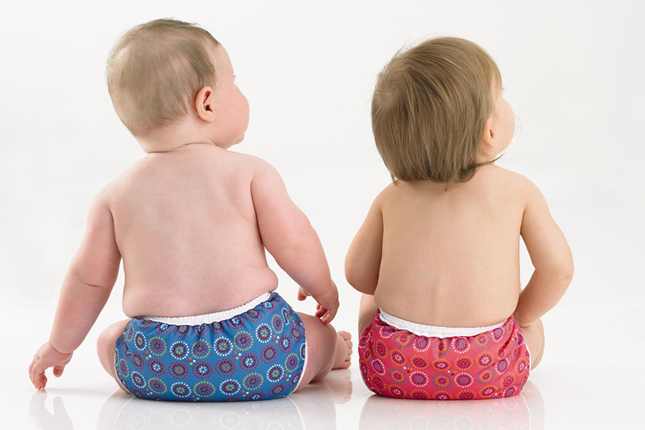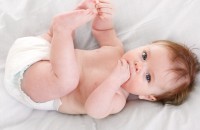Twin Talks
Cloth Diapering Your Twins
[00:00:00]
Please be advised, this transcription was performed from a company independent of New Mommy Media, LLC. As such, translation was required which may alter the accuracy of the transcription.
[Theme Music]
CHRISTINE STEWART-FITZGERALD: Did you know that there is an alternative to using disposable paper diapers? Cloth diapering is an economical and green option that many twin parents are choosing every day. So joining us today are our expert twin panelists who are passionate about cloth diapering and we’re here to share the secrets of cloth diapering your twins. This is Twin Talks.
[Theme Music/Intro]
CHRISTINE STEWART-FITZGERALD: Well welcome to Twin Talks, broadcasting from birth education center of San Diego. Twin Talks is your weekly online on the go support group for expecting and new parents of twins. I’m your host Christine Stewart-Fitzgerald. Now have you heard about the Twin Talks club?
Our members get bonus content after each new show plus special giveaways and discounts. Subscribe to our monthly Twin Talks newsletter and learn about the latest episodes available. Another way for you to stay connected is by downloading our free Twin Talks app and it’s available from most smart phones. So before we get started, let’s go around and introduce our panelist Tammy, tell us about your family.
TAMMY RENEY: Hi I’m Tammy Reney. I’m a mother to identical twin boys who are 8 months old. We just relocated to San Diego from the desert last august and we’ve been having a lot of fun here and I’m really excited for my boys because they’re going to get to grow up in this beautiful city.
CHRISTINE STEWART-FITZGERALD: Wow an 8 month you know I have to say so you’re 8 month that’s getting over the hurdle you’ve gotten over a lot I mean hopefully you’re sleeping through night.
TAMMY RENEY: Oh they are. That’s just great.
CHRISTINE STEWART-FITZGERALD: Awesome. And Shelly.
SHELLY STEELY: I’m Shelley. I’m the producer here at Twin Talks. I have identical twin boys who just turned two and they don’t even sleep through the night sometimes. So I’m jealous and I’m at 35 weeks pregnant with a singleton girl. So we start cloth diapering my boys when they were about 7-8 months.
We switched because of blowouts and leaks. I mean my kids could pee and poop through every diaper on the market so we switched right about once we kind of had the hang of things and loved it so much I would be cloth diapering from the start for this one. I also wanted to let you guys listening at home know about our virtual panelist program. So not everybody is lucky enough to live in our beautiful city so if you can’t make it into the studio, you can follow along from the comfort of your own home.
We have a Facebook page you can follow and you can also follow us on Twitter. If you want to become part of the conversation you can use the #twintalksvp to ask an answer questions.
CHRISTINE STEWART-FITZGERALD: Well awesome.
[Theme Music]
SUNNY GAULT: We had a comment from one of our listeners that we wanted to share to all of you. This comes from Julie in Michigan and Julie writes hey Twin Talks. I wanted to thank you for your episode of having twins after having a singleton. My husband and I have a 3 year old girl and we just found out we’re pregnant with identical twins but do not yet know the gender.
This came as a huge surprise to us because we never even consider twins is a possibility and we even plan to have just two children total. Oops. Again thanks for the episode. We’re not really sure what to expect with twins and we don’t want our first child to feel any less special when the new babies arrived. Well Julie thank you so much for writing this. We have a fun time recording that episode and we’re glad that it helped.
[Theme Music]
CHRISTINE STEWART-FITZGERALD: Today’s topic is cloth diapering your twins. A lot of people and I think cloth diapering they have this image of you know what it was like maybe like 30 plus years ago.
TAMMY RENEY: White square.
CHRISTINE STEWART-FITZGERALD: Yes the white square and like pins, you know like safety pins and it’s like oh my gosh it’s change so much.
TAMMY RENEY: Exactly.
CHRISTINE STEWART-FITZGERALD: So much over the years and you know I admit when I was researching on cloth diapering you know I kind of had to get over that image too because you know…
TAMMY RENEY: Me too.
CHRISTINE STEWART-FITZGERALD: It’s now you know we started out with prefolds and I was amazed that they’ve got little device you know if you’ve used in something similar with snappy things.
TAMMY RENEY: Yeah those look really cool. I’ve seen them.
CHRISTINE STEWART-FITZGERALD: Yeah. Now I think Shelly di you did you use…
SHELLY STEELY: Yeah so we look in the clothe diapering and like I mentioned earlier we didn’t start until the boys were a little bit older. Our main challenge is we don’t have laundry in our apartment.
CHRISTINE STEWART-FITZGERALD: Ooh that’s tough.
SHELLY STEELY: We have a shared laundry and so it was the idea of getting two newborns tune in from the laundry room multiple times a day was over whelming and you know diaper services it’s just the prefolds and the cover and it seemed really tricky and overwhelming.
I was just picturing lots of the weird folds and twist and plastic pants and clothes not fitting in all that but once we actually jump into it, it’s totally different than what it was and I know everyone I know that my mom’s age who’s seen the diapers can’t even believe that they’re diapers you know they look so different.
There’s pocket diapers, there’s all in one, there’s fitteds, there’s hybrids I mean whatever your diaper needs are there is a company that makes them for you and they’re adorable.
CHRISTINE STEWART-FITZGERALD: I know they’re cute. We got some on the table just to show our viewers. I mean it looks nothing like this kind of ugly you know plastic [inaudible] things that we think of you know from years ago.
SHELLY STEELY: But they still serve the same function they’re just as…
CHRISTINE STEWART-FITZGERALD: Yeah.
SHELLY STEELY: Usable.
CHRISTINE STEWART-FITZGERALD: I want I mean I love this little prints.
TAMMY RENEY: They’re cute.
CHRISTINE STEWART-FITZGERALD: Those are just cute. And I know I know that you got you got boy that you got boy and girl it could work either way.
TAMMY RENEY: Yeah.
SHELLY STEELY: They are just so fun and babies are attracted to bright and colorful things. I found my boys just touching their diapers.
CHRISTINE STEWART-FITZGERALD: Oh yeah. It’s fun you know what it’s I have to admit like you know when I put my singleton in diaper and she wears little dresses and you know she is jumping around and looks it’s cute.
TAMMY RENEY: Yeah.
CHRISTINE STEWART-FITZGERALD: And then when I see I mean as soon as we know we do use disposable if we you know go a long distance trip or something and it just I don’t know I just don’t like - it’s like okay you got a piece of paper on your butt.
TAMMY RENEY: Yeah.
SHELLY STEELY: And our weather here is so nice I mean I love being able to put the boys on just the diaper and have that be their outfit for the day.
TAMMY RENEY: Yeah.
CHRISTINE STEWART-FITZGERALD: Yeah.
TAMMY RENEY: I mean…
CHRISTINE STEWART-FITZGERALD: Yeah.
TAMMY RENEY: This looks like pants.
CHRISTINE STEWART-FITZGERALD: I know.
TAMMY RENEY: You know so…
CHRISTINE STEWART-FITZGERALD: It really it really does. Yeah I mean it’s their fashion accessory. So what was the main motivation when you guys decided to into cloth diapering? I mean there’s a lot of reason to do it. What are some of the main considerations for you?
SHELLY STEELY: Ours was mess. So my boys I mean they pee through everything ever since they were born really I mean every time they woke up during the night they would’ve leak through their diaper, they’re sleeper, our sheets times two I mean I think I mentioned you before the show we went through 800 diapers…
CHRISTINE STEWART-FITZGERALD: Oh my gosh.
SHELLY STEELY: In our first month at home and we have to have at least 6 sleepers for each boy because we were just doing so much laundry and the blowouts I mean those early like breast fed baby blowouts. It was…
CHRISTINE STEWART-FITZGERALD: So where you having blowouts…
SHELLY STEELY: It was awful.
CHRISTINE STEWART-FITZGERALD: In disposable.
SHELLY STEELY: Yeah in disposables. I mean everything and I was at my wits end because you know and I was I remember standing over my sink scrubbing the like 10th outfit you know in a week and thinking if I’m already hand washing poop out of clothing every single day why not just switch to cloth you know.
CHRISTINE STEWART-FITZGERALD: Right.
SHELLY STEELY: I know moms talk about cutting a oncey off because of a blowout here or there. We have those blowouts daily and I couldn’t afford to get buying new clothes.
CHRISTINE STEWART-FITZGERALD: Oh my gosh.
SHELLY STEELY: So yeah I mean we were just for us it was it the disposable diapers didn’t worked for my boys and once we enter the world of cloth it was life changing.
CHRISTINE STEWART-FITZGERALD: Wow. Wow. So how about you when did you decide?
TAMMY RENEY: Well two reasons really. First it was really you know a love for the environment and when we produce waste, that enters our water source and to me that’s scary. And then when we found out that we before we even found out that we were having twins, we already agreed on cloth diapering. And then when we found out that we had twins, we were expecting twins you know we did the math and they were going to need a lot of things for the rest of their lives or until they move out.
And so just by just through cloth diapering the money that we could have spent on disposables can now be spent on more important things for them…
CHRISTINE STEWART-FITZGERALD: Oh absolutely.
TAMMY RENEY: You know.
CHRISTINE STEWART-FITZGERALD: Absolutely. I know I think when we found out we are having twins I mean just as like oh my gosh you know like all this preparation and then buying stuff and then thinking about you know diapers that just the cost of it alone is pretty significant. And we were like okay how can we cut corners.
TAMMY RENEY: Yeah.
CHRISTINE STEWART-FITZGERALD: Wherever possible. So you know and I think I mean in terms of cost I know we got some figures that talk about what that cost savings can be. So I think now I’ve read as we were looking at the real diapers association website and they’re doing there are some statistics that are posted there and it estimates that if let’s say the average disposable diaper is somewhere between 15-20 cents a piece right and you know we’ve got each kids going through 8-10 diapers a day and then it spells it out to that the average cost per kid can be somewhere in the neighborhood of like 1500 to 2000 dollars in total.
So of course you multiply that times two so you’re looking at what 3 to 4 thousand dollars you know like that’s just crazy.
SHELLY STEELY: It’s going to it’ going to depend on how many diapers your kids go through I mean like I said my boys went through a lot of diapers so those numbers wouldn’t been accurate. I’ve seen lower numbers too. I’ve seen it more like 800 to a thousand dollars per kid. And then you know depending on the kind of cloth diapers you buy I mean some are more expensive than others.
But I think you touch on it earlier really the benefit is that second year you know your diapers are still going to be good if you have more children. I mean this my singleton that is due on august I mean here diapers are basically free. We already have them. And then another thing to consider is the resell value so disposable diaper that’s 20 cents that you’re throwing away every hour times two every day. I mean it’s your just throwing money in the trash.
CHRISTINE STEWART-FITZGERALD: Yeah. So comparatively okay if let’s say just if disposable diapers are going to cost let’s just say you know 1800 dollars a year per kid, so then what is what’s the cost of using cloth diapers? And I think we said like easier…
SHELLY STEELY: It’s going to depend on the kind of diapers you use.
TAMMY RENEY: Right.
SHELLY STEELY: So cloth diapers aren’t just a luxury. I mean you don’t have to be a collector. You can still use prefolds and covers and you can spend a minimum amount I’ve seen numbers less than 500 total you know prefolds and covers. I think and there’s a brand out there who says you know cloth diaper your kid from birth to two for a hundred dollars. So there’s cheap options, prefolds, flats, covers.
I mean if you’re looking to save money, those options are there. I’m more of like a collector. We like the fun prints and limited editions but those have a high resell value so some diapers I got that were cute that we use for a little bit of time I can turn on and sell for the same or more than what I paid for them.
CHRISTINE STEWART-FITZGERALD: Oh that’s great. Yeah. And you know and that…
SHELLY STEELY: So…
CHRISTINE STEWART-FITZGERALD: I have to say on the money…
SHELLY STEELY: Making money out of diapers.
CHRISTINE STEWART-FITZGERALD: Yeah. Yeah. And I bought mine used so I went on online sort of you know swapping site and so I bought mine for like you know 50% of the retail value. So and then as you say…
SHELLY STEELY: Now I’ve heard people say how could you possibly buy used diapers and to me the same way you can buy any kind of use baby clothing. If you’re buying infant clothing 0-12 months some baby has spit up on it, feed on it, or poop in it you know.
CHRISTINE STEWART-FITZGERALD: Right.
SHELLY STEELY: I mean they have they just have.
CHRISTINE STEWART-FITZGERALD: Right.
SHELLY STEELY: So it’s really not it’s not any different you know our laundry machines are good. We’ve got bleached. We’ve got sunshine. You can get a stain out.
CHRISTINE STEWART-FITZGERALD: Right.
TAMMY RENEY: And it’s not like you are putting something dirty on your child.
CHRISTINE STEWART-FITZGERALD: Right.
TAMMY RENEY: It’s washed you know.
CHRISTINE STEWART-FITZGERALD: Yes. Yeah.
SHELLY STEELY: It’s just laundry.
CHRISTINE STEWART-FITZGERALD: Yeah exactly. You know I was looking at the statistics again in the real diapers circle site, you know I think there are some figures that are a little bit older but they’re saying that let’s see there are 300 million dollars were spent annually just to discard disposable diapers were as cotton diapers are reused 50 to 200 times before turning into rags. And then it said that disposable diapers are the third largest single consumer item in landfills…
TAMMY RENEY: Wow. Wow.
CHRISTINE STEWART-FITZGERALD: And represent about 4% of solid waste and each house with the child in diapers, disposable make up 50% of household waste. I mean…
SHELLY STEELY: You know with the cloth diaper too when you’re kids are done being diapered I mean cotton is cotton and microfiber is great so we actually use microfiber inserts to clean our TV…
CHRISTINE STEWART-FITZGERALD: Yeah.
SHELLY STEELY: You can also use it to clean your car.
CHRISTINE STEWART-FITZGERALD: Oh interesting. Oh I would have never thought of that.
SHELLY STEELY: Microfibers are very absorbent. The cotton ones prefolds they make good number of cloths you can even pass them down. They’re good for household cleaning if you’re trying to go kind of go green at home and so the paper towels I mean you know fabric is it’s not like when your baby is done with it you have to throw it away. You can resell it or you can repurpose it which we all knew we can’t do with disposables.
CHRISTINE STEWART-FITZGERALD: Oh yeah. Yeah. And then you know what I know a lot of people want to talk about you know the sort of the carbon footprint and look at sort of the supply chain and you know cleaning and another one here says that over 300 pounds of wood, 50 pounds of petroleum feed stocks and 20 pounds of chlorine are used to produce disposable diapers for one baby each year. So and I think it’s kind of you know cool if you can say hey I’m saving this, you know I’m saving trees and I’m saving you know you know all the pollution in the air. How about health and hygiene?
SHELLY STEELY: In terms of health reasons diaper rashes are significantly less common on cloth diapers.
TAMMY RENEY: Oh absolutely.
SHELLY STEELY: So babies can be allergic to disposables and we had a lot less rashes when we switch to cloth so for a sensitive baby it can be a really good option and like you said you know it’s not unsanitary at all. You’re washing them and so they can really be healthy. You can use natural diaper creams on your babies so it think if you’re concerned about what goes next to your baby’s skin you have a baby with allergies, sensitivities to materials then cloth is really a good health choice.
CHRISTINE STEWART-FITZGERALD: Well you know we’re going to take a break and when we come back we’re going to talk about some of the different types of cloth diapers that are available on the market.
[Theme Music]
CHRISTINE STEWART-FITZGERALD: Well welcome back and today we are talking with our panelist here about cloth diapering and talking about what are the different types of cloth diapers. We’ve mentioned pockets, prefolds I mean what are these and how was it different from you know when we think about those big square you know piece of you know diapers from years ago?
SHELLY STEELY: We could talk about forever about cloth diapers I mean anyone of these is a need to know and everybody has their own preferences but if you’re just considering cloth diapers, we will just give you like a brief overview of the types and there’s actually really good videos. If you go on YouTube, you can find a video that will explain in depth and show you each kind better than we have time for here.
But just to give you kind of a basic idea, so your first option is the original one that’s from 30 years ago. There’s really nothing wrong with it you know. It’s cheap. It’s going to be your simplest option and so that would be a flat or a pre-fold with the cover. So flats and pre-folds are made out of cotton sometimes bamboo cotton and it’s a big piece of fabric and you fold it. So a pre-fold is design to be folded into thirds.
It’s called the pre-fold because it will have sometimes lines in it where you can fold along it and the flat is just a giant piece of fabric. You can even use what they called flour sack towels. You can get them at like Walmart, Target, whatever. And with these it’s all about how you fold it to fit your babies. So you can still buy diaper pins but most people prefer like you said it’s a piece of rubber that kind of hooks in to the fabric and holds the diaper together.
So with that you’re going to need a pre-fold or a flat, you need to learn how to fold it on your baby, you need to fasten it somehow whether it’s that plastic or the pins and you need a water proof cover over it. So that’s them. Use to be those plastic pants. You can still buy those but there’s a lot of cuter more.
You know more kind of fun trendier options and that you can get them with snaps or with dockets. So that’s your most basic. Those are nice because they’re the easiest to washed, they’re one layer of fabric so that everything washes out really quickly an then every time the baby gets wet that you change the flat or the prefold but the cover as long as there is not poop on it you can just reuse. You can wipe it out inside.
CHRISTINE STEWART-FITZGERALD: It’s very economical. Yeah I found I mean because in using that type of system you might only need to have maybe 3 or 4 covers and then you know you get a whole bunch of prefolds. Yeah.
SHELLY STEELY: Yeah and so prefolds were around a dollar each.
CHRISTINE STEWART-FITZGERALD: Yeah.
SHELLY STEELY: Sometimes there’s a little more less if you buy them used. And again it’s a piece of cotton so you can just keep reusing it until it falls apart. And then the covers they vary in price anywhere from 5 to 20 dollars depending on how fancy but again you only need a couple of them. The next option and what tends to be I’ve seen most popular these days are pockets.
So a pocket diaper is still that kind of cover with the plastic inside of it but it has a sawn in pocket where you stuff and insert into it. And that insert would be usually made out of microfiber. Microfiber that something that you might have seen they use it to dry like dry the windows of a car wash because it’s highly absorbent. It’s those hello towels…
CHRISTINE STEWART-FITZGERALD: Right. Yeah.
SHELLY STEELY: So it’s a really absorbent kind of blended fabric and you stuff the microfiber insert into the pocket. Now with that the benefit is you stuff them ahead of time and then it goes on just like a disposable. It’s all one piece. You snap it on your baby. When it’s dirty you unsnap it and you toss it in the wash. So those are popular with dads in day cares.
CHRISTINE STEWART-FITZGERALD: Yeah.
SHELLY STEELY: Grandparents.
CHRISTINE STEWART-FITZGERALD: Yes.
SHELLY STEELY: And they are simple and you can customize the absorbency. So my boys were very heavy wetters so we would use different kinds of inserts sometimes two or three inserts even for night time.
CHRISTINE STEWART-FITZGERALD: Now I think those are really a great option because like you said you can have you know different thicknesses of inserts and different materials of inserts. It’s like I got some of those that are using hemp and I really wasn’t familiar with that at all but I mean oh my gosh I actually think the hemp is even more absorbable…
SHELLY STEELY: It is. So microfibers…
CHRISTINE STEWART-FITZGERALD: than some other type of… yeah.
SHELLY STEELY: Absorbs quickly.
CHRISTINE STEWART-FITZGERALD: Yeah.
SHELLY STEELY: And it’s trimmer. So to get a really high absorbency with cotton, you’re going to have a lot of fluff microfiber will be thinner than the cotton would be. Hemp is great because it’s absorbent and trim but it’s also kind of pricey. So hemp inserts are going to run you a lot more than a microfiber insert would. So to build a full stash all help inserts…
CHRISTINE STEWART-FITZGERALD: Right.
SHELLY STEELY: Probably not the cost saving option that you want. But you can get blends. We like a blend of bamboo and microfibers. So that fast absorbency of microfiber with that staying power of bamboo. Then there’s all in one diapers. All in ones are even easier than pockets because the whole diaper is all attach.
CHRISTINE STEWART-FITZGERALD: Yes.
SHELLY STEELY: So it’s a cotton layer that can go right next to baby’s skin because microfibers can’t and then it’s actually sawn in in the diaper. So you don’t have to stuff anything. You just you take the diaper, you wash it, you put it on the baby and you wash it again.
CHRISTINE STEWART-FITZGERALD: Yeah.
SHELLY STEELY: The drawback of an all in one is that you can’t customize the absorbency the way you can with the pocket.
CHRISTINE STEWART-FITZGERALD: Right.
SHELLY STEELY: The benefit again it really, really simple just one piece, no stuffing, no…
CHRISTINE STEWART-FITZGERALD: And it’s great for care providers and you think oh my gosh you know if you are taking your kids to you know babysitters or day care or something like that. You really don’t have to explain it to them. I mean it’s like that you can hand them here’s the all in one and here’s the in here you put the dirty diaper in here and put the new diaper on just like a disposable. I mean I love the simplicity of those.
SHELLY STEELY: And they’re nice and nice and trim options. We love the all in ones underpants because they are much thinner than a pocket diaper or the bulkier prefolds. And then you’ve got hybrid diapers which are there’s also all in twos and then the hybrid systems. You guys might have heard about this. What hybrid systems are you can use a reusable cloth inserts so like a cotton or a bamboo insert or you can use a disposable insert for traveling.
So it’s got that outer plastic shell that’s going to keep the wetness in but if you are traveling and you don’t want to have to worry about diaper laundry, you can get disposable inserts. So you stick the insert in and you wrap it on baby. You toss the disposable part. You save the cover for the next diaper change.
CHRISTINE STEWART-FITZGERALD: Yeah. Yeah. I mean I think that’s a really great option if because it really combines the convenience I think and there and you got a really great fit too you know with the diapers. So and I think there’s you know when you hear a lot about some of the more green companies you know they can give you, you know you can either buy like you said the cloth inserts or disposable inserts or you know depending on you know what you’re looking for. Okay well we talk about some different types of diapers, how about for doing laundry? Because I mean obviously we got to wash them. What does are either special laundry considerations and you know what does your routine look like?
TAMMY RENEY: Well with a soiled diaper, I would first rinse it out and then you know just sort in a hanging wet bag until it’s I have like a good amount and then I would wash them in an all-natural detergent. I wouldn’t name the brand but it’s all-natural, it’s safe, it’s good for cloth diapers and then just a cupful of T3 oil and that really disinfects and deodorizes. And that’s it. You know it’s really easy.
CHRISTINE STEWART-FITZGERALD: That’s pretty straight forward. Yeah.
SHELLY STEELY: Yeah so there’s I mean you could spend hours getting lost in different people’s wash routines and everybody have something different that works for them but the simplest wash routine is you want to do a first rinse to get off anything extra any of like extra soiled…
TAMMY RENEY: Yeah.
SHELLY STEELY: Rinse out the urine because if you don’t rinse your diapers out first you’re just washing them in dirty water.
CHRISTINE STEWART-FITZGERALD: Exactly.
SHELLY STEELY: You can do that rinse by hand, we did to save a wash cycle, or you can do that rinse in your washing machine then you’re going to want to do like a real full heavy duty wash with some kind of soap. Any internet search will give you tons of cloth diaper friendly soaps and they’re generally sensitive and environment friendly too. So you might end up using that for your whole family’s laundry. And then you want a final rinse just to make sure that you got the detergent out of your diapers.
CHRISTINE STEWART-FITZGERALD: Yeah.
SHELLY STEELY: So it’s I mean it’s a little bit longer than a normal laundry but totally doable nothing crazy.
CHRISTINE STEWART-FITZGERALD: Now how often do you guys do laundry?
TAMMY RENEY: Once every other day.
SHELLY STEELY: Yeah every other day.
CHRISTINE STEWART-FITZGERALD: Okay. So you know I guess I must be to like totally lazy because so we bought enough diapers so we can go about like two and half three days without having to do laundry.
SHELLY STEELY: Yeah you wouldn’t want to go more than 3 days because it will stink first of all but the longer the soiled longer soiled laundry sits the more time it kind of have to absorb in the fabric so they don’t recommend going more than 3 days. You can also get there’s a couple different kinds of spays like a live active enzyme spray or like a soak so we would actually spray all of our diapers and that would kind of start working on the bacteria while the diapers are waiting in the pail. So…
CHRISTINE STEWART-FITZGERALD: Now okay what about poopy diapers? I mean that’s kind of like the big questions like oh my gosh you know people often have this picture of like oh I’ve got poopy diapers and thinking about again thirty years ago swishing it around on a toilet and like no really it’s not like that anymore. It’s a lot easier. Now I know in our case we have a diaper sprayer which essentially like one of those that looks like you know those sprayers in the kitchen sink that hand sprayer…
TAMMY RENEY: Yeah I’ve been looking I’ve been wanting one of those. Is it good in getting like…
CHRISTINE STEWART-FITZGERALD: Yeah. You know what we love it. Oh my gosh now I mean I look online you can purchase diaper sprayers as are available kind of prepackaged. But my husband and I we look it up and there was a DIY sight and it shows us how to put it together. It cost us less than 20 bucks you know from the local hardware store and it just attach to the toilet and it provides enough pressure that you know you literally just kind of hold the diaper over the toilet and jus spray the poop off and it just falls off. So…
SHELLY STEELY: Cool.
CHRISTINE STEWART-FITZGERALD: So there’s just a little bit of residual it kind of looks like you know a spot and then when you to throw it in into the washer it’s just it’s not there. So I know poopy diapers everybody just like ooh.
SHELLY STEELY: Well first of all like if you happen to be breastfeeding, breastfed poop is water soluble so you don’t need to rinse your diapers at all. If your babies are breastfed, it doesn’t matter how dirty they are you don’t have to scrape anything. They just go in a regular wash. Once your baby is eating solid or if you’re formula feeding or doing some combination you do want to get that poop off. We were on old fashion ways we swish in the toilet or rinse in the sink.
CHRISTINE STEWART-FITZGERALD: Oh yeah.
SHELLY STEELY: Rubber gloves bleach your sink you know I mean and like I said I understand some people are ick out by the idea of poop but let’s be perfectly honest if you have twins you’re touching poop all the time.
CHRISTINE STEWART-FITZGERALD: Yeah.
TAMMY RENEY: Absolutely.
SHELLY STEELY: And if you think diapers are gross wait until you start potty training. I mean I’m not kidding your life is just on other people’s poop.
CHRISTINE STEWART-FITZGERALD: Yes.
SHELLY STEELY: I dream of a day where I won’t ever have to touch anyone else’s poop. But it’s part of life you know…
CHRISTINE STEWART-FITZGERALD: Yeah.
SHELLY STEELY: Diapers don’t make it any cloth diapers don’t make it any grosser. It’s the same poop you’re probably still touching it.
CHRISTINE STEWART-FITZGERALD: We talk a little bit about kind of the gear that we need. So when you know you setup to do diapering we think okay we need diapers and then we’ve you know where do we put and store the diapers and doing laundry. So what would you recommend to parent’s when they’re starting out like what are the essential items?
TAMMY RENEY: I think just storage is pretty easy. We just bought like one of those plastic drawers on target and then we just use that to store our diapers. But honestly we go through them so quickly we don’t even have the time to fold them.
SHELLY STEELY: Yeah I mean in terms of gear on a basic level you need a wet bag…
TAMMY RENEY: Yeah.
SHELLY STEELY: Or a pail liner. We use a regular trash can and we have a pail liner. It’s basically like a reusable garbage bag. It’s plastic on the inside and fabric on the outside. We have two of them. When the pail is full, you take it to that laundry, put on a clean one and then you just wash the liner with your laundry and that’s all the gear we needed. And a wet bag for travel if you’re doing cloth when you go out and about.
So a wet bag is just like a pail liner, plastic on the inside fabric on the outside. When you’re done with cloth diapers, the pail liner is still great for regular laundry and the wet bags are great for wet swimsuits, dirty cloths, messes, etc. So they are long term use. I have a couple of wet bags that we keep just for changes of clothes because kids are messy.
CHRISTINE STEWART-FITZGERALD: Now I agree. We kind of do the same thing like we’ve got some just basically a kitchen a trash can with the little step. You know the flip up top and then with the bag, the liners and you know use that and then we’ve got a two story house so we end up having like two separate diaper changing stations so we get like you know one for each station just so it’s convenient.
We’re not worrying about like oh my gosh where do I you know put the diapers. Well thank so much to everybody for joining us today and for more information about cloth diapering your twins or for more information about any of our speakers and panelists, visit the episode page on our website. Now this conversation continues for members of our Twin Talks club and after the show our panelist are going to talk about why cloth diapering is really worth that extra effort. And for more information about the Twin Talks club, visit our website www.newmommymedia.com .
[Theme Music]
SUNNY GAULT: Hey Twin Talks we have a special new segment on the show it’s called “We’re expecting what?” It seems like every twin parent has that moment that story of when they first found out that they’re pregnant with twins and so we want to give you guys and opportunity to share your we’re expecting what moments with us. This comes from Alli and she wrote this on our Facebook page.
She says I brought home my son a gran-pics and showed them to my 5 year old. I told him that when the babies come out we can go and visit nana. He seemed fine with that answer. Two weeks later he came in to my room and asked if the babies could come out and play today. I told him no it’s way too early and they are too small and would be very sick and he told me that’s okay nana will make them better.
Nana makes everything better doesn’t she? So if you want to share some funny stories of when you first found out your pregnant with twins, we would love to hear them and include them on the show. You can either send us and email or call our voicemail at 619-866-4775.
[Theme Music]
CHRISTINE STEWART-FITZGERALD: Well, that wraps up our show for today. We appreciate you listening to Twin Talks.
Don’t forget to check our sister show:
• Preggie Pals for expecting parents
• Our show The Boob Group for moms who breastfeed their babies and
• Parent Savers, your parenting resource on-the-go.
This is Twin Talks parenting times two.
[Disclaimer]
This has been a New Mommy Media production. Information and material contained in this episode are presented for educational purposes only. Statements and opinions expressed in this episode are not necessarily those of New Mommy Media and should not be considered facts. Though information in which areas are related to be accurate, it is not intended to replace or substitute for professional, Medical or advisor care and should not be used for diagnosing or treating health care problem or disease or prescribing any medications. If you have questions or concerns regarding your physical or mental health or the health of your baby, please seek assistance from a qualified health care provider.
SUNNY GAULT: New Mommy Media is expanding our line up of shows for new and expecting parents. If you have an idea for a new series or if you’re a business or organization interested in joining our network of shows through a co-branded podcast, visit www.NewMommyMedia.com
[00:30:31]
[End of Audio]










